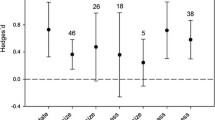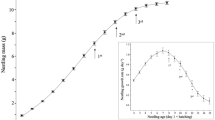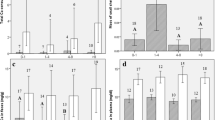Abstract
Food availability influences multiple stages of the breeding cycle of birds, and supplementary feeding has helped in its understanding. Most supplementation studies have reported advancements of laying, whilst others, albeit less numerous, have also demonstrated fitness benefits such as larger clutches, shorter incubation periods, and greater hatching success. Relatively few studies, however, have investigated the effects of supplementary feeding for protracted periods across multiple stages of the breeding cycle. These effects are important to understand since long-term food supplementation of birds is recommended in urban habitats and is used as a tool to increase reproductive output in endangered species. Here, we compare the breeding phenology and productivity of blue tits Cyanistes caeruleus and great tits Parus major breeding in food-supplemented and non-supplemented blocks in a broadleaf woodland in central England over three seasons (2006–2008). Supplementation was provided continuously from several weeks pre-laying until hatching, and had multiple significant effects. Most notably, supplementation reduced brood size significantly in both species, by half a chick or more at hatching (after controlling for year and hatching date). Reduced brood sizes in supplemented pairs were driven by significantly smaller clutches in both species and, in blue tits, significantly lower hatching success. These are novel and concerning findings of food supplementation. As expected, supplementary feeding advanced laying and shortened incubation periods significantly in both species. We discuss the striking parallels between our findings and patterns in blue and great tit reproduction in urban habitats, and conclude that supplementary feeding may not always enhance the breeding productivity of birds.



Similar content being viewed by others
References
Amundsen T, Lorentsen S-H, Tveraa T (1996) Effects of egg size and parental quality on early nestling growth: an experiment with the Antarctic petrel. J Anim Ecol 65:545–555
Ankney CD, Johnson SL (1985) Variation in weight and composition of brown-headed cowbird eggs. Condor 87:296–299
Arcese P, Smith JNM (1988) Effects of population density and supplemental food on reproduction in song sparrows. J Anim Ecol 57:119–136
Bland RL, Tully J, Greenwood JJD (2004) Birds breeding in British gardens: an underestimated population? Bird Study 51:97–106
Blondel J, Maistre M, Perret P, Hurtrez-Bousses S, Lambrechts MM (1998) Is the small clutch size of a Corsican blue tit population optimal? Oecologia 117:80–89
Bosque C, Bosque MT (1995) Nest predation as a selective factor in the evolution of developmental rates in altricial birds. Am Nat 145:234–260
Boutin S (1990) Food supplementation experiments with terrestrial vertebrates: patterns, problems, and the future. Can J Zool 68:203–220
Boyce MS, Perrins CM (1987) Optimizing great tit clutch size in a fluctuating environment. Ecology 68:142–153
Castro I, Brunton DH, Mason KM, Ebert B, Griffiths R (2003) Life history traits and food supplementation affect productivity in a translocated population of the endangered hihi (stitchbird, Notiomystis cincta). Biol Conserv 114:271–280
Chamberlain DE, Cannon AR, Toms MP, Leech DI, Hatchwell BJ, Gaston KJ (2009) Avian productivity in urban landscapes: a review and meta-analysis. Ibis 151:1–18
Charnov EL, Krebs JR (1974) On clutch-size and fitness. Ibis 116:217–219
Cramp S, Perrins CM (1993a) Blue tit. In: Cramp S, Perrins CM (eds) The birds of the western palearctic, vol 7. Oxford University Press, Oxford, pp 225–248
Cramp S, Perrins CM (1993b) Great tit. In: Cramp S, Perrins CM (eds) The birds of the western palearctic, vol 7. Oxford University Press, Oxford, pp 255–281
Cresswell W, McCleery R (2003) How great tits maintain synchronization of their hatch date with food supply in response to long-term variability in temperature. J Anim Ecol 72:356–366
Davies NB, Lundberg A (1985) The influence of food on time budgets and timing of breeding of the dunnock Prunella modularis. Ibis 127:100–110
de Neve L, Soler JJ, Ruiz-Rodríguez M, Martín-Gálvez D, Pérez-Contreras T, Soler M (2007) Habitat-specific effects of a food supplementation experiment on immunocompetence in Eurasian magpie Pica pica nestlings. Ibis 149:763–773
Deeming DC (2002) Avian incubation: behaviour, environment, and evolution. Oxford University Press, Oxford
Drent RH, Daan S (1980) The prudent parent: energetic adjustments in avian breeding. Ardea 68:225–252
Eeva T, Lehikoinen E, Pohjalainen T (1997) Pollution-related variation in food supply and breeding success in two hole-nesting passerines. Ecology 78:1120–1131
Eikenaar C, Berg ML, Komdeur J (2003) Experimental evidence for the influence of food availability on incubation attendance and hatching asynchrony in the Australian reed warbler Acrocephalus australis. J Avian Biol 34:419–427
Ewald PW, Rohwer S (1982) Effects of supplemental feeding on timing of breeding, clutch-size and polygyny in red-winged blackbirds Agelaius phoeniceus. J Anim Ecol 51:429–450
Gosler AG (1993) The great tit. Hamlyn, London
Grieco F, van Noordwijk AJ, Visser ME (2002) Evidence for the effect of learning on timing of reproduction in blue tits. Science 296:136–138
Gustafsson L, Sutherland WJ (1988) The costs of reproduction in the collared flycatcher Ficedula albicollis. Nature 335:813–815
Harrison TJE (2010) A curate’s egg: feeding birds during reproduction is ‘good in parts’. A study of blue tits Cyanistes caeruleus and great tits Parus major. PhD dissertation, University of Birmingham, Birmingham
Hill WL (1988) The effect of food abundance on the reproductive patterns of coots. Condor 90:324–331
Houston D, McInnes K, Elliott G, Eason D, Moorhouse R, Cockrem J (2007) The use of a nutritional supplement to improve egg production in the endangered kakapo. Biol Conserv 138:248–255
Jansson C, Ekman J, Von Brömssen A (1981) Winter mortality and food supply in tits Parus spp. Oikos 37:313–322
Jones DN, Reynolds SJ (2008) Feeding birds in our towns and cities: a global research opportunity. J Avian Biol 39:265–271
Jones PJ, Ward P (1976) Level of reserve protein as proximate factor controlling timing of breeding and clutch-size in red-billed quelea Quelea quelea. Ibis 118:547–574
Källander H, Karlsson J (1993) Supplemental food and laying date in the European starling. Condor 95:1031–1034
Kelly JF, Van Horne B (1997) Effects of food supplementation on the timing of nest initiation in belted kingfishers. Ecology 78:2504–2511
Kempenaers B, Adriaensen F, Dhondt AA (1998) Inbreeding and divorce in blue and great tits. Anim Behav 56:737–740
Lack D (1954) The natural regulation of animal numbers. Oxford University Press, Oxford
Lack D (1966) Population studies of birds. Clarendon, Oxford
Lessells CM (1986) Brood size in Canada geese: a manipulation experiment. J Anim Ecol 55:669–689
Lyon BE, Montgomerie RD (1985) Incubation feeding in snow buntings: female manipulation or indirect male parental care. Behav Ecol Sociobiol 17:279–284
Mänd R, Tilgar V, Lõhmus A, Leivits A (2005) Providing nest boxes for hole-nesting birds—does habitat matter? Biodivers Conserv 14:1823–1840
Martin TE (1987) Food as a limit on breeding birds: a life-history perspective. Annu Rev Ecol Syst 18:453–487
Meijer T, Drent R (1999) Re-examination of the capital and income dichotomy in breeding birds. Ibis 141:399–414
Minitab (2007) Meet Minitab 15 for Windows. Minitab Inc., State College
Minot EO, Perrins CM (1986) Interspecific interference competition—nest sites for blue and great tits. J Anim Ecol 55:331–350
Naef-Daenzer B, Widmer F, Nuber M (2001) Differential post-fledging survival of great and coal tits in relation to their condition and fledging date. J Anim Ecol 70:730–738
Nager RG, van Noordwijk AJ (1995) Proximate and ultimate aspects of phenotypic plasticity in timing of great tit breeding in a heterogeneous environment. Am Nat 146:454–474
Nager RG, Rüegger C, van Noordwijk AJ (1997) Nutrient or energy limitation on egg formation: a feeding experiment in great tits. J Anim Ecol 66:495–507
Nilsson JÅ (1991) Clutch size determination in the marsh tit (Parus palustris). Ecology 72:1757–1762
Nilsson JÅ (1993) Energetic constraints on hatching asynchrony. Am Nat 141:158–166
Nilsson JÅ (1994) Energetic bottle-necks during breeding and the reproductive cost of being too early. J Anim Ecol 63:200–208
Nilsson JÅ (2000) Time-dependent reproductive decisions in the blue tit. Oikos 88:351–361
Nilsson JÅ, Smith HG (1988) Incubation feeding as a male tactic for early hatching. Anim Behav 36:641–647
Norris K (1993) Seasonal variation in the reproductive success of blue tits: an experimental study. J Anim Ecol 62:287–294
Nur N (1984) The consequences of brood size for breeding blue tits II. Nestling weight, offspring survival and optimal brood size. J Anim Ecol 53:497–517
Oehlert GW (1992) A note on the delta method. Am Stat 46:27–29
Perrins CM (1965) Population fluctuations and clutch-size in the great tit, Parus major L. J Anim Ecol 34:601–647
Perrins CM (1979) British tits. Collins, London
Perrins CM, McCleery RH (1989) Laying dates and clutch size in the great tit. Wilson Bull 101:236–253
Perrins CM, Moss D (1975) Reproductive rates in the great tit. J Anim Ecol 44:695–706
Pettifor RA, Perrins CM, McCleery RH (1988) Individual optimization of clutch size in great tits. Nature 336:160–162
Ramsay SL, Houston DC (1997) Nutritional constraints on egg production in the blue tit: a supplementary feeding study. J Anim Ecol 66:649–657
Ramsay SL, Houston DC (1998) The effect of dietary amino acid composition on egg production in blue tits. Proc R Soc Lond B 265:1401–1405
Reynolds SJ, Mänd R, Tilgar V (2004) Calcium supplementation of breeding birds: directions for future research. Ibis 146:601–614
Robb GN, McDonald RA, Chamberlain DE, Bearhop S (2008a) Food for thought: supplementary feeding as a driver of ecological change in avian populations. Front Ecol Environ 6:476–484
Robb GN, McDonald RA, Chamberlain DE, Reynolds SJ, Harrison TJE, Bearhop S (2008b) Winter feeding of birds increases productivity in the subsequent breeding season. Biol Lett 4:220–223
Robbins CT (1981) Estimation of the relative protein cost of reproduction in birds. Condor 83:177–179
Rohwer FC (1986) Composition of blue-winged teal eggs in relation to egg size, clutch size, and the timing of laying. Condor 88:513–519
Rytkönen S, Orell M (2001) Great tits, Parus major, lay too many eggs: experimental evidence in mid-boreal habitats. Oikos 93:439–450
Saino N, Romano M, Ambrosini R, Ferrari RP, Møller AP (2004) Timing of reproduction and egg quality covary with temperature in the insectivorous barn swallow, Hirundo rustica. Funct Ecol 18:50–57
Sanz JJ (1996) Effect of food availability on incubation period in the pied flycatcher (Ficedula hypoleuca). Auk 113:249–253
SAS Institute Inc. (2008) SAS/STAT® 9.2 user’s guide. SAS Institute Inc., Cary
Schoech SJ, Hahn TP (2008) Latitude affects degree of advancement in laying by birds in response to food supplementation: a meta-analysis. Oecologia 157:369–376
Schoech SJ, Bowman R, Reynolds SJ (2004) Food supplementation and possible mechanisms underlying early breeding in the Florida scrub-jay (Aphelocoma coerulescens). Horm Behav 46:565–573
Schoech SJ, Bowman R, Bridge ES, Boughton RK (2007) Baseline and acute levels of corticosterone in Florida scrub-jays (Aphelocoma coerulescens): effects of food supplementation, suburban habitat, and year. Gen Comp Endocr 154:150–160
Schoech SJ, Bridge ES, Boughton RK, Reynolds SJ, Atwell JW, Bowman R (2008) Food supplementation: a tool to increase reproductive output? A case study in the threatened Florida scrub-jay. Biol Conserv 141:162–173
Soler M, Soler JJ (1996) Effects of experimental food provisioning on reproduction in the jackdaw Corvus monedula, a semi-colonial species. Ibis 138:377–383
Svensson E, Nilsson JÅ (1995) Food supply, territory quality, and reproductive timing in the blue tit (Parus caeruleus). Ecology 76:1804–1812
Toms M, Sterry P (2008) Garden birds and wildlife. AA, Basingstoke
Verhulst S, Tinbergen JM (1991) Experimental evidence for a causal relationship between timing and success of reproduction in the great tit Parus m. major. J Anim Ecol 60:269–282
Visser ME, Holleman LJM, Caro SP (2009) Temperature has a causal effect on avian timing of reproduction. Proc R Soc Lond B 276:2323–2331
Walsberg GE (1983) Avian ecological energetics. Academic, New York
Wiebe KL, Martin K (2000) The use of incubation behavior to adjust avian reproductive costs after egg laying. Behav Ecol Sociobiol 48:463–470
Wilkin TA, Garant D, Gosler AG, Sheldon BC (2006) Density effects on life-history traits in a wild population of the great tit Parus major: analyses of long-term data with GIS techniques. J Anim Ecol 75:604–615
Wilkin TA, Gosler AG, Garant D, Reynolds SJ, Sheldon BC (2009) Calcium effects on life-history traits in a wild population of the great tit (Parus major): analysis of long-term data at several spatial scales. Oecologia 159:463–472
Williams TD (1996) Variation in reproductive effort in female zebra finches (Taeniopygia guttata) in relation to nutrient-specific dietary supplements during egg laying. Physiol Zool 69:1255–1275
Acknowledgments
This research was funded by the Natural Environment Research Council (NERC) through a studentship to TJEH, and we are grateful to CJ Wildlife Ltd. (especially Peter Deans and Chris Whittles) for providing equipment, consumables and financial support. The Worcestershire Wildlife Trust generously allowed the use of Chaddesley Woods National Nature Reserve, and we also thank Mervyn and Rose Needham for their help in facilitating this research. Numerous people provided considerable help with field, laboratory and office work, especially Munhazaya Battsengel, Ivana Budinski, Louise Gilmour, Nardie Hanson, Chan Heu, Elizabeth Kingston, Ewa Kos, Marija Majer, and Vladimir Rakić. We are grateful to Phillip Cassey, Simon Harold, and Kate Lessells for statistical advice, and to Steve Schoech and an anonymous reviewer for helpful comments on an earlier version of this paper. We declare that this research was conducted lawfully within the United Kingdom.
Author information
Authors and Affiliations
Corresponding authors
Additional information
Communicated by Douglas Robinson.
Electronic supplementary material
Below is the link to the electronic supplementary material.
Rights and permissions
About this article
Cite this article
Harrison, T.J.E., Smith, J.A., Martin, G.R. et al. Does food supplementation really enhance productivity of breeding birds?. Oecologia 164, 311–320 (2010). https://doi.org/10.1007/s00442-010-1645-x
Received:
Accepted:
Published:
Issue Date:
DOI: https://doi.org/10.1007/s00442-010-1645-x




